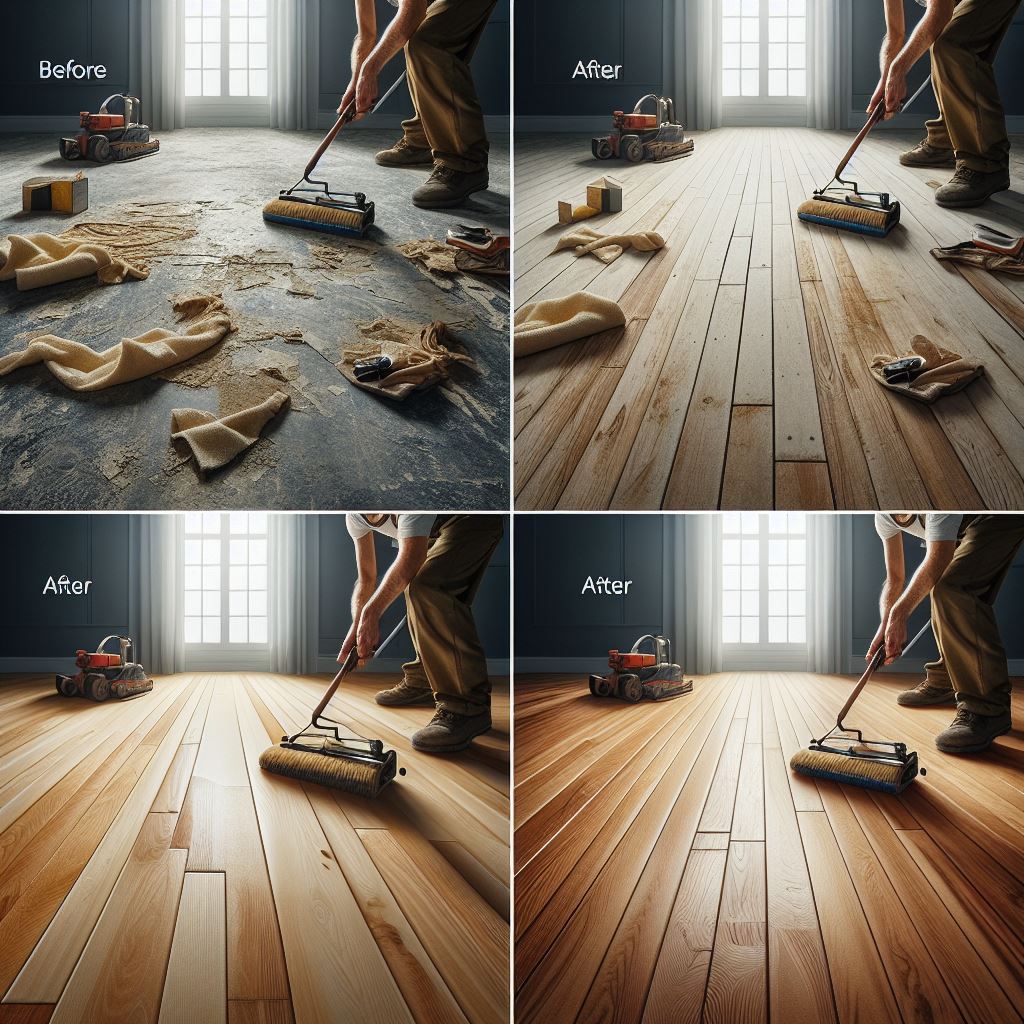When it comes to combining durability and elegance, engineered wood flooring is a top choice for homeowners and designers alike. Unlike traditional hardwood, which is milled from a single piece of timber, engineered wood is crafted from multiple layers of wood veneer, bonded together in a cross-grain construction. This unique structure makes engineered wood highly resistant to changes in temperature and humidity, making it an excellent option for various environments, including regions with fluctuating climates.
Engineered wood flooring offers numerous benefits such as ease of installation, versatility in design, and cost-effectiveness. It can mimic the appearance of expensive hardwood species while providing enhanced stability and support. These qualities make it particularly suitable for installation over radiant heat systems, where maintaining consistent temperatures is crucial for both comfort and floor longevity.
As you explore the possibilities of integrating engineered wood flooring into your home, you'll find that it not only enhances the aesthetic appeal but also adds to the overall functionality of your living spaces. Whether you're renovating a single room or undertaking a full home makeover, engineered wood flooring provides a reliable and stylish solution.
Ready to transform your home with engineered wood flooring? Request a free estimate or email us at sales@paradise-spaces.com.
What is Radiant Heat Flooring
Radiant heat flooring is a luxurious and efficient way to keep your home warm during the colder months. Unlike traditional heating systems that rely on blowing air through vents, radiant heat systems use the principle of thermal radiation to transfer heat directly from the floor to the surrounding space. This method ensures even heat distribution and eliminates the uncomfortable drafts typically associated with conventional forced-air systems.
There are two main types of radiant heat flooring systems: electric and hydronic. Electric radiant heat uses electrical cables or mats installed beneath the floor surface to generate heat. This type is generally easier to install and is ideal for smaller areas like bathrooms or kitchens. On the other hand, hydronic radiant heat involves pumping heated water through a network of tubes embedded in the floor. While hydronic systems are more complex and require a higher upfront investment, they are more energy-efficient and cost-effective in the long run, especially for larger areas or entire homes.
One of the key benefits of radiant heat flooring is its ability to maintain a consistent and comfortable temperature throughout the room. This not only enhances comfort but also improves energy efficiency by reducing the need to frequently adjust the thermostat. Additionally, radiant heat is silent, reducing noise pollution, and it doesn't circulate dust and allergens, making it a healthier option for those with respiratory issues.
When paired with engineered wood flooring, radiant heat systems provide a perfect blend of warmth, comfort, and aesthetic appeal. The stability and resilience of engineered wood make it an ideal surface material for radiant heat applications, ensuring that your floors remain beautiful and functional for years to come.
Compatibility of Engineered Wood with Radiant Heat

When considering the installation of radiant heat flooring, the compatibility of engineered wood is a crucial factor. Engineered wood flooring is specifically designed to offer superior stability compared to traditional hardwood, making it a popular choice for use with radiant heat systems.
Unlike solid hardwood, which can expand and contract significantly with changes in temperature and humidity, engineered wood is constructed with multiple layers of plywood or high-density fiberboard (HDF) topped with a veneer of real wood. This layered construction provides enhanced dimensional stability, reducing the risk of warping, cupping, or gapping when exposed to the heat fluctuations associated with radiant systems.
Additionally, the thickness of engineered wood planks typically ranges from 3/8 inch to 3/4 inch, making them more effective at conducting heat to the surface. This ensures that the warmth generated by the radiant heat system is efficiently transferred to the living space, maximizing comfort and energy efficiency.
It's important to note that not all engineered wood products are created equal, and some may be better suited for radiant heat than others. When selecting engineered wood flooring for use with radiant heat, look for products that are specifically rated for this application. Manufacturers often provide guidelines and recommendations to ensure optimal performance and longevity of the flooring.
Finally, proper installation is key to ensuring compatibility. This includes acclimating the engineered wood to the room's conditions before installation, using appropriate underlayment, and following the manufacturer's instructions for installation over radiant heat systems. Taking these steps will help to ensure that your flooring remains beautiful and functional, providing both aesthetic appeal and cozy warmth for years to come.
Pros of Engineered Wood Over Radiant Heat

Choosing engineered wood flooring over radiant heat systems comes with a plethora of benefits that make it an excellent choice for modern homes. Here are some of the primary advantages:
- Enhanced Stability: Engineered wood is designed to withstand temperature fluctuations better than solid hardwood. Its multi-layered construction minimizes the risk of warping, cupping, or gapping, ensuring a stable and durable flooring solution.
- Improved Heat Conduction: Engineered wood is generally more effective at conducting heat than other flooring options like carpet or laminate. The thinner profile of engineered wood allows efficient heat transfer, creating a warm and comfortable living environment.
- Aesthetic Appeal: Engineered wood offers the same luxurious look and feel as solid hardwood. The top veneer layer is made of real wood, providing an authentic appearance that can enhance any interior design scheme.
- Cost-Effective: While engineered wood can be more affordable than solid hardwood, it does not compromise on quality or appearance. This makes it a cost-effective option for those looking to combine radiant heat with a stylish flooring solution.
- Eco-Friendly Choice: Engineered wood uses less hardwood per plank compared to solid wood, making it a more sustainable option. Additionally, many manufacturers use eco-friendly adhesives and finishes, further reducing the environmental impact.
- Versatility: Engineered wood is available in a wide variety of finishes, colors, and wood species, giving homeowners the flexibility to choose a style that perfectly matches their decor. It can also be installed over various subfloors, including concrete, making it highly versatile.
In summary, the combination of enhanced stability, effective heat conduction, aesthetic appeal, cost-efficiency, eco-friendliness, and versatility makes engineered wood flooring an excellent choice for homes with radiant heat systems. By opting for this flooring type, you can enjoy a beautiful, warm, and comfortable living space.
Cons of Engineered Wood Over Radiant Heat

While engineered wood flooring offers numerous benefits, it's also important to consider some potential drawbacks when installing it over radiant heat systems. Here are some of the cons:
- Sensitivity to Moisture: Although engineered wood is more resistant to moisture compared to solid hardwood, it is not completely immune. Excessive moisture can still cause damage, leading to potential warping or swelling. Proper installation and moisture barriers are essential to mitigate this risk.
- Initial Cost: The upfront cost of engineered wood flooring can be higher than other flooring options like laminate or vinyl. While it provides long-term value, the initial investment may be a consideration for budget-conscious homeowners.
- Limited Refinishing: Unlike solid hardwood, which can be sanded and refinished multiple times, engineered wood has a thinner top layer that limits the number of refinishes. Typically, it can only be refinished once or twice, depending on the thickness of the wear layer.
- Installation Complexity: Installing engineered wood over radiant heat systems requires precise techniques and proper materials. Any mistakes during installation can lead to issues with heat distribution and flooring performance, necessitating professional installation to ensure optimal results.
- Potential for Surface Damage: Engineered wood, while durable, can still be susceptible to scratches, dents, and other surface damage. High-traffic areas may show wear over time, and protective measures like area rugs and furniture pads are recommended.
- Compatibility Concerns: Not all engineered wood flooring products are compatible with radiant heat systems. It's crucial to choose a product that is specifically designed and tested for use with radiant heat to avoid potential issues.
Considering these potential cons, it's essential to weigh them against the benefits and specific needs of your home. Proper planning, professional installation, and maintenance can help mitigate many of these drawbacks, ensuring that your engineered wood flooring performs well over radiant heat systems.
Installation Tips for Engineered Wood Flooring

Installing engineered wood flooring over radiant heat systems requires careful planning and attention to detail to ensure optimal performance and longevity. Here are some essential tips to help you achieve a successful installation:
- Choose the Right Product: Not all engineered wood flooring is suitable for use with radiant heat. Ensure that the product you choose is specifically designed and tested for this purpose. Look for manufacturer recommendations and specifications.
- Acclimate the Flooring: Before installation, allow the engineered wood flooring to acclimate to the room's temperature and humidity levels. This helps prevent expansion or contraction once installed, ensuring a more stable fit.
- Prepare the Subfloor: A clean, dry, and level subfloor is crucial for a successful installation. Remove any debris, ensure the subfloor is even, and use appropriate moisture barriers to protect against potential moisture issues.
- Follow Manufacturer Guidelines: Each engineered wood product may have specific installation instructions. Follow the manufacturer's guidelines closely, especially regarding the adhesive or fastening methods to be used with radiant heat systems.
- Maintain Optimal Temperature: During and after installation, maintain a consistent room temperature and avoid sudden temperature changes. Gradually increase the heat from the radiant system to prevent stress on the flooring.
- Professional Installation: Consider hiring professional installers with experience in working with both engineered wood and radiant heat systems. Their expertise can help avoid common pitfalls and ensure a flawless installation.
- Regular Maintenance: After installation, regular maintenance is key to preserving the beauty and functionality of your engineered wood flooring. Use appropriate cleaning products, avoid excessive moisture, and periodically inspect for any signs of wear or damage.
By following these installation tips, you can enjoy the combined benefits of engineered wood flooring and radiant heat, creating a warm and inviting atmosphere in your home. If you're ready to transform your space with high-quality engineered wood flooring, request a free estimate or email us at sales@paradise-spaces.com.
